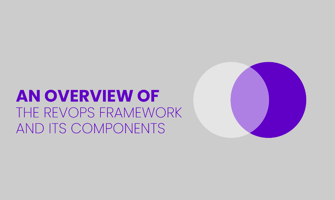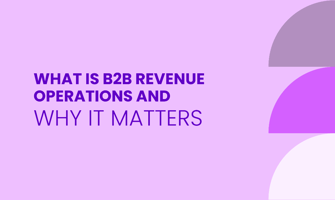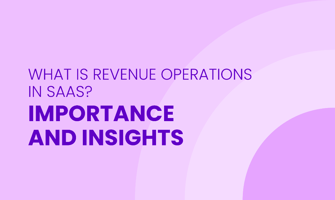Revenue Operations (RevOps) is a strategic approach designed to streamline and unify the efforts of...
Revenue Operations Framework: Key Components and How It Functions
A Revenue Operations Framework serves as the backbone for aligning sales, marketing, and customer success teams to optimize revenue growth. By integrating processes, data, and technology, this framework creates a unified system that improves efficiency and decision-making.
In this article, we will explore the key components of a Revenue Operations Framework and explain how it functions to enhance business outcomes. Read more about "revenue intelligence" in our article: "What is Revenue Intelligence? How It Works and Why It Matters."
What is a Revenue Operations Framework?
A Revenue Operations (RevOps) framework is important for businesses that want to streamline how they generate and manage revenue. It provides a structured approach to aligning your sales, marketing, and customer success teams under one unified system.
Instead of each team working independently, a RevOps framework ensures that all these critical areas collaborate toward the same goals. This alignment makes your business more efficient and helps you deliver a better customer experience.
One of the key benefits of a RevOps framework is its ability to improve collaboration across revenue-generating teams. When marketing, sales, and customer success are on the same page, you avoid common problems like miscommunication, duplicate efforts, or inconsistent customer interactions.
For example, your sales team can focus on converting qualified leads if marketing provides them with the right prospects. Meanwhile, your customer success team can ensure new customers stay satisfied and loyal, creating long-term value.
Beyond teamwork, a RevOps framework focuses heavily on efficiency. By streamlining processes and using shared tools, you eliminate wasted time and resources.
This means your teams can spend more energy on activities that directly contribute to growth, such as closing deals or improving customer retention. Over time, this operational efficiency leads to faster and more predictable revenue growth.
The business benefits of implementing a RevOps framework are significant. These include:
Improved revenue predictability: With better data visibility and team alignment, you can forecast revenue more accurately. This helps you make informed decisions about budgeting and growth strategies.
Greater operational efficiency: Standardized workflows and shared technology reduce bottlenecks and improve productivity across teams.
Enhanced customer satisfaction: Unified efforts ensure a smoother customer exploration, from the first interaction to ongoing support, fostering loyalty.
![]()
Key Components of a Revenue Operations Framework
1. People
People are the foundation of any Revenue Operations (RevOps) framework. Their roles and skills determine how effectively the framework is implemented and sustained. Without the right individuals in key positions, the entire system can fall apart.
In a RevOps team, each member has specific responsibilities that help align business functions. For example:
RevOps Managers oversee the framework, ensuring all teams—like sales, marketing, and customer success—work toward shared goals.
Data Analysts handle data collection and analysis, providing insights to guide decision-making.
Tools Specialists manage the technology stack, ensuring systems are integrated and running efficiently.
These roles require professionals with the right skills to succeed. A strong RevOps team member should be:
Skilled in analytical thinking to interpret data and identify trends.
Equipped for cross-functional collaboration, as they need to bridge gaps between departments.
Proficient in strategic planning to create workflows and strategies that drive revenue growth.
Each person's contributions ensure the RevOps framework operates smoothly, from aligning teams to achieving business goals.
2. Processes
Processes are the foundation of a Revenue Operations (RevOps) framework. They ensure that everything runs smoothly by creating clear steps for teams to follow. Without well-defined workflows, it’s easy for confusion, delays, or errors to disrupt operations.
To make the RevOps framework effective, you need to define and standardize key workflows. These workflows act as a guide for how tasks should be handled across different teams.
For example, think about how leads move from marketing to sales this transition needs to happen in a consistent, predictable way every time.
Standardization ensures that no matter who is involved, the process remains the same. It also reduces misunderstandings and helps everyone stay on the same page.
When workflows are optimized and aligned, they make operations much more efficient. Teams can focus on their work instead of figuring out what to do next or dealing with unnecessary bottlenecks. For example:
Aligning how customer data is shared between teams prevents duplication of effort.
Streamlining lead qualification steps ensures that only high-quality leads reach sales, saving time and resources.
Standardizing handoff processes ensures smoother transitions from one team to the next, such as from sales to customer success.
Clear workflows also directly impact the customer experience. When teams work seamlessly together, customers notice fewer delays, miscommunications, or errors. This creates a smoother exploration, from their first interaction with your company to ongoing support and relationship-building.
3. Technology
Technology plays a critical role in making a Revenue Operations framework more efficient. It provides the tools and platforms that help teams work better together, manage tasks, and achieve their goals.
A Customer Relationship Management (CRM) system is a crucial tool that serves as a central hub for customer data, storing contact information, purchase history, and communication records. This makes collaboration easier for sales, marketing, and customer success teams.
For example, when a sales team knows how marketing interacts with a lead, they can tailor their approach to close the deal more effectively. This shared access to information ensures everyone works with the same, up-to-date data, reducing errors and improving teamwork.
Another essential platform is marketing automation software. These tools help streamline repetitive tasks like sending emails, scheduling social media posts, or segmenting leads into different groups.
By automating these processes, marketing teams save time and stay focused on creating strategies to attract and nurture potential customers. Additionally, marketing automation improves lead generation by tracking how customers engage with content, like clicking on a link or downloading a resource, and assigns those leads to the right sales reps based on their readiness to buy.
Tools like 180ops help businesses align their revenue goals with actionable insights. By consolidating data and providing advanced analytics, 180ops ensures that decision-making is always backed by reliable and relevant information.
4. Data and Analytics
Data and analytics are important to how a Revenue Operations (RevOps) framework works. They help you make smarter decisions and ensure that your sales, marketing, and customer success teams all work toward the same goals.
To start, collecting data is the foundation of everything. It gives you the raw information you need to understand what's happening across your business.
For example, tracking things like customer behavior, sales trends, and marketing performance can reveal what’s working and what needs to change. Without accurate and consistent data, it’s hard to make decisions that truly benefit your business.
Once you have the data, the next step is to turn it into actionable insights. This is where tools like dashboards and reports come in. These tools organize all the data into easy-to-read formats, so you can quickly see patterns and trends.
For example, a dashboard might show how many leads your marketing team brought in this month or how your sales team is performing against their targets. These insights help you know where to focus your efforts to improve results.
By using data and analytics effectively, your RevOps framework becomes a powerful guide for your strategy. It ensures that your decisions are based on facts, not guesses, and gives your teams the clarity they need to achieve your revenue goals.
5. Customer Lifecycle Management
Managing the customer lifecycle is critical to the success of a Revenue Operations (RevOps) framework. It aligns your efforts with the ultimate goal: building lasting customer relationships while driving steady revenue growth.
Two major aspects of this are customer retention and customer expansion, both of which play essential roles in ensuring predictable and scalable results for your business.
Keeping existing customers engaged and satisfied is at the heart of customer retention. When your customers stay with you over time, they provide a stable and reliable revenue base. Retention doesn’t just happen it requires you to deliver consistent value, solve problems quickly, and maintain trust.
Long-term customers are more likely to renew contracts, purchase additional services, and recommend your business to others. This stability directly contributes to revenue predictability, which is important for long-term planning and growth.
Growth doesn’t come only from keeping customers it also comes from customer expansion. This concept focuses on finding opportunities to increase the value of each customer relationship. For example, you can:
Upsell: Encourage customers to upgrade to higher-tier products or services.
Cross-sell: Offer complementary products or services that improve what they already use.
Deepen engagement: Build stronger connections by understanding their needs and proactively addressing them with tailored solutions.
When done effectively, these strategies create mutual value. Customers see more benefits from your offerings, and your organization sees higher revenue per account.
By managing the customer lifecycle strategically, you align your sales, marketing, and customer success teams under shared goals.
This alignment ensures all touchpoints whether during onboarding, renewals, or upselling conversations support the RevOps framework’s mission to drive both customer satisfaction and business growth.
![]()
How the Revenue Operations Framework Functions
1. Align Teams
Collaboration is one of the most critical parts of making a Revenue Operations (RevOps) framework work. Aligning your team's sales, marketing, and customer success helps everyone stay on the same page and work toward shared goals.
When these teams operate in silos, communication often breaks down. Sales might not understand what marketing is doing, or customer success might lack context from sales interactions. This creates confusion and inefficiencies that slow down progress. By breaking down these silos, you create a space where teams can share information, ideas, and strategies.
A big part of alignment involves defining shared goals and metrics. When everyone measures success the same way, it becomes easier to work together.
For example, if sales, marketing, and customer success all focus on increasing customer retention, they can coordinate their efforts. Marketing can create campaigns targeted at current customers, sales can focus on upselling, and customer success can ensure customers are satisfied and supported.
To achieve this, you can:
Set clear, company-wide objectives that all teams contribute to.
Use common metrics, like revenue growth or customer lifetime value, to measure team performance.
Regularly bring teams together for updates and strategy sessions to ensure alignment.
When teams communicate better and share the same goals, they align their efforts with overall business objectives. This collaboration not only improves efficiency but also helps drive revenue growth and improves the customer experience.
2. Centralize Data
To make smart decisions, your teams need accurate and reliable data. This is why creating a single source of truth is so important. A single source of truth means storing all your key data in one centralized location, instead of spreading it across different tools or systems.
Doing this ensures that everyone in your organization is working with the same numbers, reducing errors and avoiding confusion caused by inconsistent data.
When your data is centralized, it becomes much easier for different teams like sales, marketing, and customer support to access and use it. This accessibility allows every department to base their decisions on facts instead of guesses. For example:
Sales teams can quickly see customer histories to tailor their pitches.
Marketing teams can analyze campaign performance to focus on what works.
Customer support can address issues faster by having immediate access to client records.
Centralized data also speeds up decision-making because you don’t need to waste time searching for information or questioning its accuracy. Instead, everyone can trust the data and focus on using it to improve outcomes.
By consolidating your data into one reliable system, you lay the foundation for smarter, faster, and more aligned decision-making across your entire organization.
3. Streamline Processes
Streamlining processes is important for making a Revenue Operations (RevOps) framework effective. It helps reduce wasted time, improve coordination, and ensure every part of your operations runs smoothly.
One important way to achieve this is through automation. By using tools and software to handle repetitive tasks, you can free up your teams to focus on more valuable work.
For example, automating data entry or lead assignment eliminates manual errors and speeds up key processes. This approach reduces inefficiencies and helps your team work faster and with greater accuracy.
Another key aspect is workflow optimization. Clear, structured workflows make it easier for teams to collaborate, especially when multiple departments are involved. You need to identify bottlenecks or steps that slow down your operations and adjust them to create a seamless process.
For example, ensuring marketing, sales, and customer success teams share the same tools and data can eliminate miscommunication and delays. This alignment improves both internal efficiency and the customer experience.
4. Drive Revenue Growth
A Revenue Operations (RevOps) framework is important for helping businesses increase revenue in a structured, strategic way. By fostering team alignment and focusing on customer value, it creates a clear path toward stronger financial outcomes.
Team alignment is one of the most critical ways the RevOps framework drives revenue growth. When sales, marketing, and customer service teams work together toward common goals, their combined efforts become far more effective.
This alignment ensures that each team supports the other's marketing attracts the right leads, sales closes deals efficiently, and customer service strengthens long-term relationships. The result is improved sales performance, with fewer missed opportunities and more deals closed.
A key factor in sustainable revenue growth is increasing customer lifetime value (CLV). The RevOps framework helps businesses achieve this by enabling targeted strategies like cross-selling, upselling, and retention.
Cross-selling introduces customers to additional products or services they might need, while upselling encourages them to move to premium options. Retention focuses on keeping customers engaged and satisfied so they continue to buy over time.
Together, these strategies ensure customers contribute more value to the business over their entire lifecycle.
5. Enhance Customer Experience
Improving the customer experience is a major focus of a Revenue Operations framework because it directly impacts customer satisfaction and loyalty.
When you create consistent and personalized interactions, you build stronger relationships with customers. This helps them feel valued and understood, making them more likely to stay with your company over time.
One way personalization strengthens these relationships is by tailoring your communication and offerings to fit what each customer needs. For example:
Sending product recommendations based on their purchase history.
Offering customized solutions for their specific challenges.
Addressing them by name and remembering past interactions.
These actions show customers that your business pays attention to them, which increases their trust and commitment.
Another key part of improving customer satisfaction is proactive support. Instead of waiting for customers to report problems, anticipate their needs and solve potential issues early. You can achieve this by:
Monitoring customer activity to spot signs of confusion or frustration.
Reaching out with helpful tips or resources before they ask for help.
Following up after purchases to ensure everything is working smoothly.
This approach reduces frustration and makes customers feel cared for. When their experience is consistently positive, they are more likely to recommend your brand to others and stay loyal to your services.
Conclusion
Implementing a Revenue Operations Framework is essential for businesses aiming to maximize their revenue potential through aligned teams and streamlined processes.
By focusing on core components like data management, process optimization, and technology integration, companies can achieve better collaboration and smarter decision-making.
Tools like 180ops play a vital role in this process by aligning revenue goals with actionable insights, ensuring that data-driven decisions back every strategy.
A well-executed framework not only boosts efficiency but also provides actionable insights for sustainable growth.
FAQ
What is a Revenue Operations Framework?
A Revenue Operations Framework is a structured approach to aligning sales, marketing, and customer success teams. It helps streamline processes, unify data, and leverage technology to drive consistent revenue growth.
Why is a Revenue Operations Framework important?
It’s important because it creates efficiency, reduces silos between teams, and ensures all departments work toward shared revenue goals. This alignment improves decision-making and maximizes revenue outcomes.
How does data management fit into the Revenue Operations Framework?
Data management is a core component of the framework. It involves collecting, organizing, and analyzing data from multiple sources to provide actionable insights that guide sales and marketing strategies.
What role does technology play in the Revenue Operations Framework?
Technology enables the automation and integration of tools used by sales, marketing, and customer success teams. This ensures seamless collaboration and allows for accurate tracking of revenue-related activities.
How can businesses implement a Revenue Operations Framework?
Businesses can implement the framework by first assessing their current operations, then aligning their processes, integrating technology, and focusing on data quality. Training teams to collaborate and adapt to the framework is also key to success.




